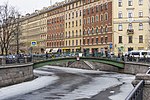Obukhovsky Bridge
Bridges in Saint Petersburg

The Obukhovsky or Obukhov Bridge (Russian: Обуховский мост) is a bridge in St. Petersburg, Russia. It carries Moskovsky Prospekt over the Fontanka River. It was originally built as a stone bridge in 1785–86 to replace a 1717 wooden bridge, and was named after the builder. It was substantially modified in 1865 and again in 1938–1940.
Excerpt from the Wikipedia article Obukhovsky Bridge (License: CC BY-SA 3.0, Authors, Images).Obukhovsky Bridge
Moskovskiy Avenue, Saint Petersburg
Geographical coordinates (GPS) Address External links Nearby Places Show on map
Geographical coordinates (GPS)
| Latitude | Longitude |
|---|---|
| N 59.921694 ° | E 30.317812 ° |
Address
Обуховский мост
Moskovskiy Avenue
190031 Saint Petersburg (округ Измайловское)
Saint Petersburg, Russia
Open on Google Maps










